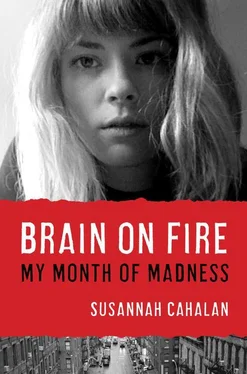“He’s working on your daughter’s case. He’s a brilliant doctor,” Dr. Russo said.
Dr. Souhel Najjar had joined my team after a call from Dr. Siegel. His skill in solving a few mystery cases had earned him a reputation as the man to go to when nothing made sense. And now Dr. Bugsy was offering up his most perplexing case to him.
“I’m at a loss,” Dr. Siegel confided to Dr. Najjar. “I need your help on this case.” He listed all the issues and conflicting diagnoses. The psychiatrists suspected that my behavior stemmed from a mental illness; the elevated white blood cell count pointed to infection; all the other tests were coming back negative. Dr. Najjar’s first guess was that I had to be suffering from some sort of viral encephalitis, an inflammation most likely caused by the herpes virus. He didn’t buy the schizoaffective theory and instead suggested that they administer an infusion of IV acyclovir, an antiviral drug.
But then the virus panel came back negative. I did not have HIV or herpes simplex virus 1 or 2 and did not test positive for herpes encephalitis, so he stopped the antiviral infusions. The other possibility was that it was some sort of autoimmune response, which he could treat with an experimental immunotherapy that he had tried successfully on another patient with brain inflammation; the treatment included steroids, intravenous immunoglobulin (IVIG), and plasma exchange.
“I think we should do IVIG treatment immediately,” Dr. Najjar said after looking over my negative virus panel.
On April 2, the nurses started my first round of five intravenous immunoglobulin (IVIG) infusions. The clear IV bags hung on a metal pole above my head, their liquid trickling down into my vein. Each of those ordinary-looking bags contained the healthy antibodies of over a thousand blood donors and cost upwards of $20,000 per infusion. One thousand tourniquets, one thousand nurses, one thousand veins, one thousand blood-sugar regulating cookies, all just to help one patient.
IVIG is made up of serum antibodies called immunoglobulin G, or IgG, which are the most common type of antibody found in the human body. 27IVIG is approved by the U.S. Food and Drug Administration to treat problems relating to transplants, leukemia, and pediatric HIV, among other conditions; its off-label uses have often been considered “experimental” and denied by insurance companies.
Antibodies are created by the body’s immune system to counteract an unwanted, external element, such as when a pathogen of some sort—a virus, bacterium, fungus, or other foreign substance—enters the body. 28This sets off a series of reactions beginning with the body’s basic alarm system, the innate response, which is a one-size-fits-all process designed to get rid of unwanted visitors quickly. If the innate system can’t eradicate the pathogen, the next defense stage is the “adaptive response,” which tailors itself to the specific intruder, using an arsenal of white blood cells and antibodies. This takes much longer to mobilize than the innate response, ten days versus the innate system’s minutes or hours. 29Usually the collateral damage of these internal battles results in familiar flulike symptoms such as headache, fever, muscle ache, nausea, and enlarged lymph nodes. 30

An immune cell, called a phagocyte, “eating” a pathogen.
One type of white blood cell, the B-cell, also can morph into plasma cells that create antibodies. 31Under normal conditions, each antibody fits exactly to only one pathogen, like Cinderella’s glass slipper, with the purpose of blocking the spread of infection by either disabling that specific kind of pathogen or flagging it for destruction. But autoantibodies, which everyone has in healthy doses, can sometimes transform into the most malicious type of biological shadowboxer, if they begin to attach to and destroy the healthy host tissue, like the brain. An IVIG infusion introduces fresh, healthy antibodies to fuse with those “bad” rogue autoantibodies created by a sick person’s immune system, helping to neutralize them and rendering the autoantibodies harmless.

Beep, beep, beep. It’s dark. There’s the beeping of a massive machine to my right. There’s a wire hooking me up to heaving bags of white liquid. I put Stephen’s headphones on and close my eyes. I am far, far away from here. I am myself again.
“This next song is to my friend Leah who couldn’t be here tonight…”
The hum of the guitar. The soft tap on the drums. The swell of the music. It’s Halloween night at Harlem’s Apollo Theater. I’m at a Ryan Adams concert. I can see him onstage, strumming on his guitar, but I can’t keep my eyes open to watch the scene. I feel a touch on my skin. It makes me shudder. I hear a voice.
“SuSHana, time to take vitals.”
The concert disappears, dissolving into the dark hospital room, the nurse next to me. I’m back, back in the place where there is no night and there is no day. It’s this woman’s fault I’m back here. I’m suddenly filled with blinding, focused rage. I wind my right arm back and punch her in the chest. She gasps.
The next morning, my mother took her usual place beside me in a chair by the window when her phone rang. It was James. My parents had been keeping him uninformed about the severity of my illness, not wanting to worry him and disrupt his studies. He and I had always been close, despite the five-year age difference, and our parents knew he would drop everything and come home if he discovered how bad off I was. But today, for the first time, she decided to hand off the phone to me.
“James… James… James,” I said, hearing my brother’s voice on the other line. “James… James… James.”
In his dorm room in Pittsburgh, James choked back tears. I sounded so different, so unlike his big sister. He insisted, “I’m going to come home soon. And you’re going to get better.”
The following day, while I was on my second course of IVIG treatment, Dr. Arslan, the psychopharmacologist, came by on rounds and noticed that my speech problems had worsened. He wrote the following in his progress note:

It was the first time that anyone had mentioned the term catatonia, a stage defined by absence, by inability, by nonbehaviors. The mnemonic that doctors use to diagnose catatonia is WIRED ’N MIRED: 32
• Waxy flexibility/catalepsy (muscular rigidity and fixedness of posture)
• Immobility/stupor
• Refusal to eat or drink
• Excitement
• Deadpan staring
• Negativism/negative symptoms
• Mutism
• Impulsivity
• Rigidity
• Echolalia (automatic repetition of words or statements said by another person)
• Direct observation
Catatonia comes from the misfiring of neurons. That “muscular rigidity,” also called posturing, occurs when the chemical link is severed between the patient’s awareness of her body and the feeling of comfort and appropriateness of movement. In other words, a catatonic patient cannot sense his or her body in space, and therefore cannot appropriately adjust. The result is that a person sits very still in awkward, atypical, unnatural poses. Catatonia is more akin to the results of a botched lobotomy than a persistent vegetative state because the person is technically still active. There are behaviors of a sort, as bizarre, nonresponsive, and inappropriate as they may be.
Читать дальше















